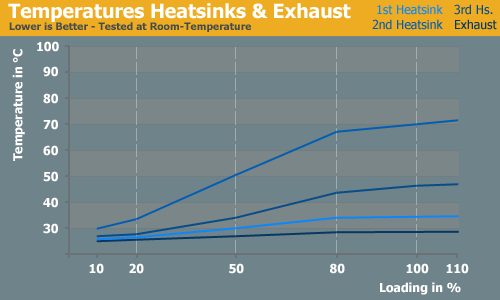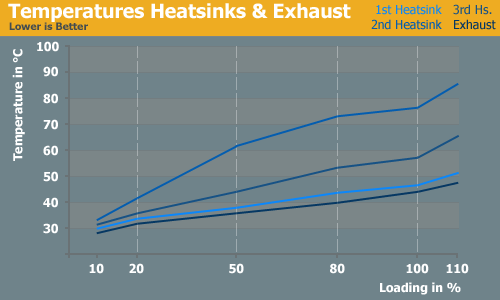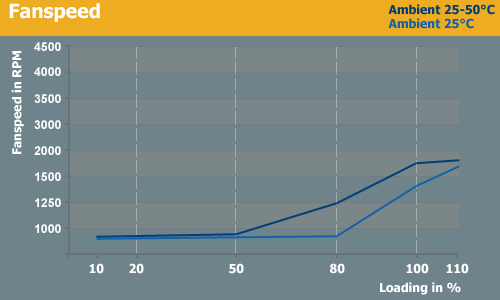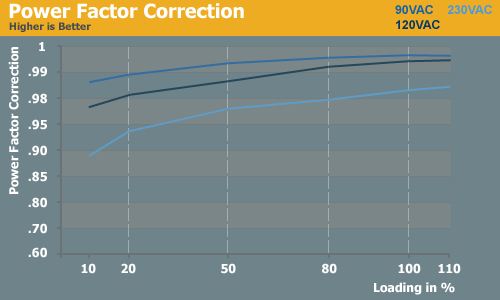400-450W PSU Roundup
by Christoph Katzer on November 6, 2007 4:00 AM EST- Posted in
- Cases/Cooling/PSUs
Corsair PFC, Temperature, Fan Speed, and Acoustics


Again, we find that the exhaust temperature is much lower than the heatsink temperatures. This indicates the heatsinks are not properly dissipating heat into the streaming air. Instead, the heat stays inside the power supply and builds up over time. While the positioning of the fan and perhaps the airflow might be to blame, the more likely problem is that the heatsinks simply aren't large enough and lack sufficient surface area. In our stress test heat chamber, we see the temperatures that are twice as high as the exhaust temperature, with the secondary heatsink reaching 85°C at the worst-case 110% load. Running a PSU under such conditions for an extended period of time would almost certainly result in a dead power supply, but it did manage to survive our short-term stress test.


Up to medium load, the power supply is extremely quiet registering less than 20dB(A). Higher loads result in increased fan speed and noise levels, and in our stress chamber we reach a maximum noise level of 28dB(A) at 80% of load (350W). However, 28dB(A) is still very quiet so in terms of noise levels users should be very pleased with Corsair. The problem is, low noise levels and low fan RPMs contribute to the relatively high heat sink temperatures. We are not sure if Corsair really tested this unit under stressful conditions - maximum load and a high ambient temperature - and we would caution users against using any of these power supplies in such an environment. Under more sedate operating conditions, however, the Corsair 450VX performs extremely well.



Again, we find that the exhaust temperature is much lower than the heatsink temperatures. This indicates the heatsinks are not properly dissipating heat into the streaming air. Instead, the heat stays inside the power supply and builds up over time. While the positioning of the fan and perhaps the airflow might be to blame, the more likely problem is that the heatsinks simply aren't large enough and lack sufficient surface area. In our stress test heat chamber, we see the temperatures that are twice as high as the exhaust temperature, with the secondary heatsink reaching 85°C at the worst-case 110% load. Running a PSU under such conditions for an extended period of time would almost certainly result in a dead power supply, but it did manage to survive our short-term stress test.


Up to medium load, the power supply is extremely quiet registering less than 20dB(A). Higher loads result in increased fan speed and noise levels, and in our stress chamber we reach a maximum noise level of 28dB(A) at 80% of load (350W). However, 28dB(A) is still very quiet so in terms of noise levels users should be very pleased with Corsair. The problem is, low noise levels and low fan RPMs contribute to the relatively high heat sink temperatures. We are not sure if Corsair really tested this unit under stressful conditions - maximum load and a high ambient temperature - and we would caution users against using any of these power supplies in such an environment. Under more sedate operating conditions, however, the Corsair 450VX performs extremely well.











37 Comments
View All Comments
Christoph Katzer - Tuesday, November 6, 2007 - link
Yep, otherwise it's just getting too long and I thought actually nobody is too interested in that analyses anyway. Let me work something out for the next ones...Ripple is also coming today, I updated the 1200-1300 roundup already.
Super Nade - Tuesday, November 6, 2007 - link
Good to know! I understand that it is going to take a considerable amount of work at the outset, to do a bit of design analysis, but once you have the popular topologies employed figured out it should be a lot less work.The length of the review is unimportant if it makes an interesting read. (Hypothetical example) Having 10 pages on the fans employed is going to be be boring. Since you have a wide audience with varying degree of technical appetite, the length of the review should not matter if the content is arranged appropriately.
Best wishes,
S-N
floffe - Tuesday, November 6, 2007 - link
When referring to the 8800GT article, it'd be nice to point out that those 327W from the wall was with SLI. A single card didn't get much over 200W, so even the Ultra should be able to run that, however horrible it otherwise is a a PSU.As for the market, I just wish someone would produce a high quality 300W modular PSU. That'd be plenty for my needs.
xsilver - Tuesday, November 6, 2007 - link
Would you be ok if they charged you the same as a 400w PSU? because for the manufacturers, they're not going to the trouble of making another PSU that costs them almost exactly the same to make.(its like asking for a car with only 15hp because thats all u need ;)
jonnyGURU - Tuesday, November 6, 2007 - link
Exactly. The cost difference at that level is rarely more than a $1. So if it costs me $30 to build a 400W, and $29 to build a 350W, etc. why would I bother?Souka - Wednesday, November 7, 2007 - link
maybe because some people "think" a 350w power supply consumes 50w less than a 400w power supply...:)
Hinkdog - Tuesday, July 21, 2020 - link
My 430 watt Antec Earthwatts that I bought in 2008 just failed. 12 years, pretty cool. Guess the 80mm fan didn't hurt its longevity. I know no one is going to read this in 2020 but wanted to post it anyway.